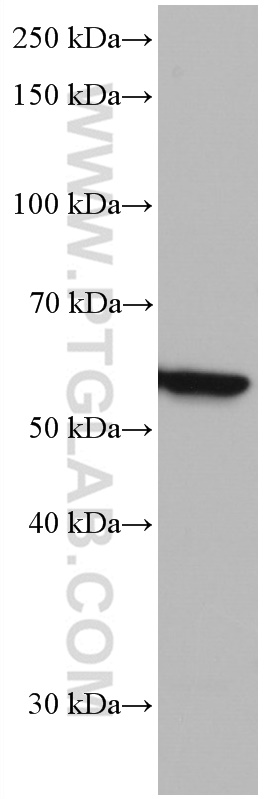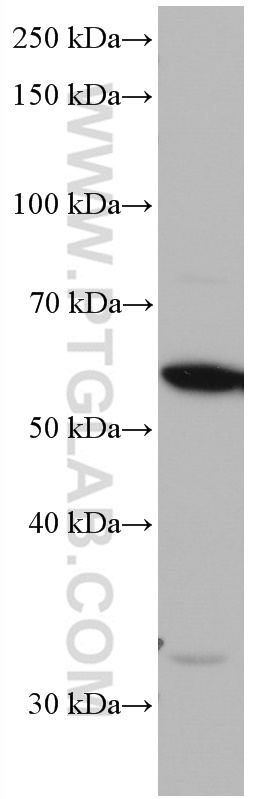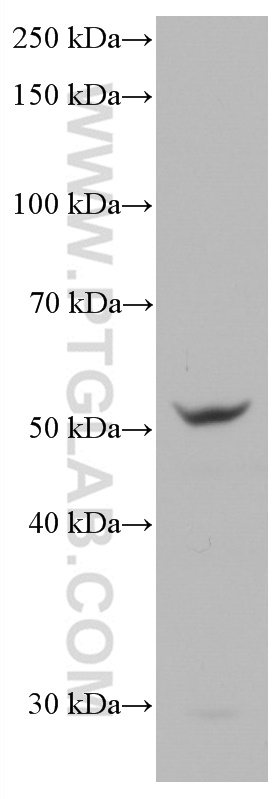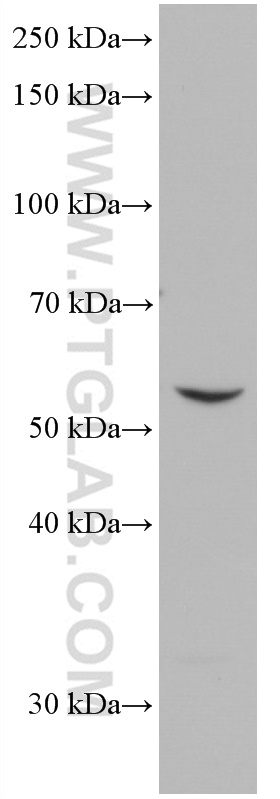验证数据展示
经过测试的应用
| Positive WB detected in | A549 cells, HeLa cells, THP-1 cells, RAW 264.7 cells |
推荐稀释比
| 应用 | 推荐稀释比 |
|---|---|
| Western Blot (WB) | WB : 1:1000-1:6000 |
| It is recommended that this reagent should be titrated in each testing system to obtain optimal results. | |
| Sample-dependent, Check data in validation data gallery. | |
产品信息
66835-1-Ig targets IRF5 in WB, ELISA applications and shows reactivity with Human, mouse samples.
| 经测试应用 | WB, ELISA Application Description |
| 经测试反应性 | Human, mouse |
| 免疫原 | IRF5 fusion protein Ag5442 种属同源性预测 |
| 宿主/亚型 | Mouse / IgG1 |
| 抗体类别 | Monoclonal |
| 产品类型 | Antibody |
| 全称 | interferon regulatory factor 5 |
| 别名 | interferon regulatory factor 5, IRF 5, IRF5, SLEB10 |
| 计算分子量 | 56 kDa |
| 观测分子量 | 56 kDa |
| GenBank蛋白编号 | BC004201 |
| 基因名称 | IRF5 |
| Gene ID (NCBI) | 3663 |
| RRID | AB_2882178 |
| 偶联类型 | Unconjugated |
| 形式 | Liquid |
| 纯化方式 | Protein G purification |
| 储存缓冲液 | PBS with 0.02% sodium azide and 50% glycerol , pH 7.3 |
| 储存条件 | Store at -20°C. Stable for one year after shipment. Aliquoting is unnecessary for -20oC storage. |
背景介绍
IRF5, also named as SLEB10, contians one IRF tryptophan pentad repeat DNA-binding domain and belongs to the IRF family. It is a transcription factor involved in the induction of interferons IFNA and INFB and inflammatory cytokines upon virus infection. It is activated by TLR7 or TLR8 signaling. Genetic variations in IRF5 are associated with susceptibility to inflammatory bowel disease type 14 (IBD14) and systemic lupus erythematosus type 10 (SLEB10). IRF5 is also used as M1 marcrophage lineage marker. Alternative splice variant encoding different isoforms exist.
实验方案
| Product Specific Protocols | |
|---|---|
| WB protocol for IRF5 antibody 66835-1-Ig | Download protocol |
| Standard Protocols | |
|---|---|
| Click here to view our Standard Protocols |



